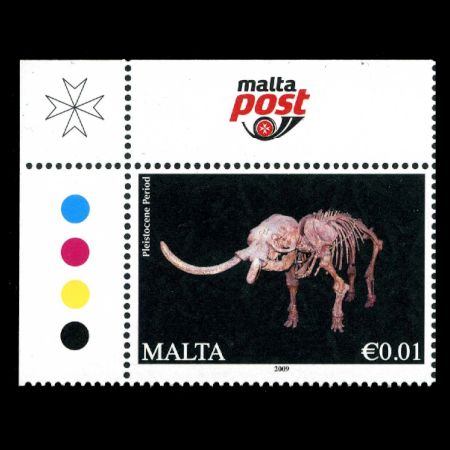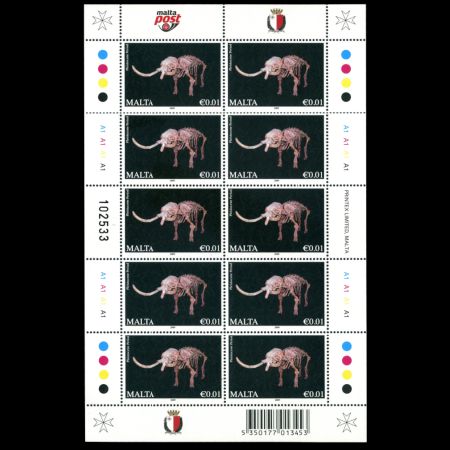Malta 2011 "Reprint of some definitive stamps from 2009"
| <prev | back to index | next> |
| Issue Date | 19.10.2011 |
| ID | Michel: Scott: Stanley Gibbons: Yvert: Category: pF |
| Design | Edward Pirotta and Paul Psaila |
| Stamps in set | 2 |
| Value | 1c - Skeleton of Prehistoric animal (Pleistocene Epoch) 37c - Painting (Norman and Hohenstaufen Period) |
| Emission/Type | definitive |
| Issue place | |
| Size (width x height) | 44 mm x 31 mm |
| Layout | Mini-Sheet of 10 stamps |
| Products | Non |
| Paper | Maltese Cross watermarked |
| Perforation | 14 x 14 |
| Print Technique | offset |
| Printed by | Printex Ltd |
| Quantity | 1.200.000 stamps |
| Issuing Authority | Malta Post p.l.c. |

Following the reprint of Se-tenant Sheet with the entire set of definitive stamps on May 23rd, 2011, the Post Authority of Malta reprinted two stamps of the set on October 19th, 2011:
- stamp with face value of Euro cent 1, depicting fossilized skeleton of a dwarf elephant. The Mini-Sheet numbers: 40001-160000
- stamp with face value of Euro cent 37, depicting a picture of two warriors. The Mini-Sheet numbers: 50001-138000
 |
| Comparison of the reprinted and original designs of the stamp with a skeleton of the dwarf elephant Elephas falconeri. |
The Mini-Sheet from 2009 has a rectangular logo with blue background while the text is written in white and gold colours.
The logo on the Mini-Sheet from 2011 has a round shape, with white background while the text is written in black and red colours.
A fossil skeleton of the dwarf elephant, Elephas falconeri, is depicted on one of the stamps with a face value of Euro cent 1 (€0,01).
This fossil was found in the Ghar Dalam Cave which is located on the outskirts of Birzebbuga, Malta. The cave contains remains of animals that were stranded and subsequently went extinct on Malta at the end of the Ice Age.
Dwarf elephant, hippopotamus, deer and bear bone deposits found there are of a different age; the hippopotamuses became extinct about 180.000 years ago, whilst the deer species became extinct much later, about 18.000 years ago. It is also here that the earliest evidence of human settlement on Malta, some 7.400 years ago, was discovered.
The cave was first scientifically investigated in 1885, but was not opened to the public until 1933. It was used as an air-raid shelter during World War II. A museum was set up on site by the then curator of Natural History Dr. J.G. Baldacchino. In 1980, the most important and irreplaceable relics such as four tusks of dwarf elephants and the skull of a Neolithic child were stolen from the museum.
The cave was investigated in 1987 under the direction of Emanual Anati, Professor of paleontology at Lecce University. His team of Italian archaeologists from Centro Camuno di Studi Preistorici discovered Palaeolithic cave art depicting human hands, anthropozoomorphic, and several animal designs from underneath the stalagmatic formations. Some depict elephants which have been extinct in the Maltese region since the Pleistocene.
Products and associated philatelic items
| Mini-Sheet | Example of Circulated Covers | |
 |
 |
|
References

|
- Technical details and official press release:
Malta Post (PDF file). - Elephas falconeri / Palaeoloxodon_falconeri:
Wikipedia. - Gar Dalam Cave:
Wikipedia.
Acknowledgements
Many thanks to Dr. Peter Voice, PhD Department of Geological and Environmental Sciences, Western Michigan University, USA, for reviewing of a draft of this article.| <prev | back to index | next> |